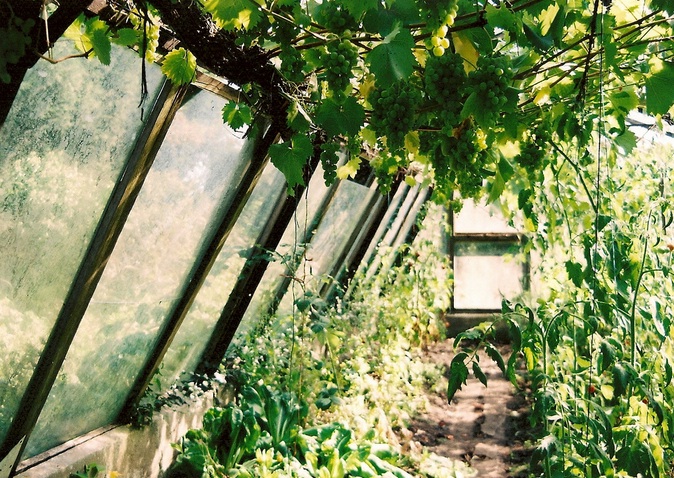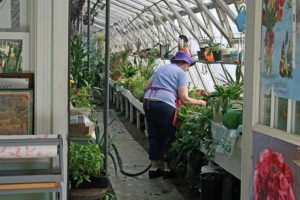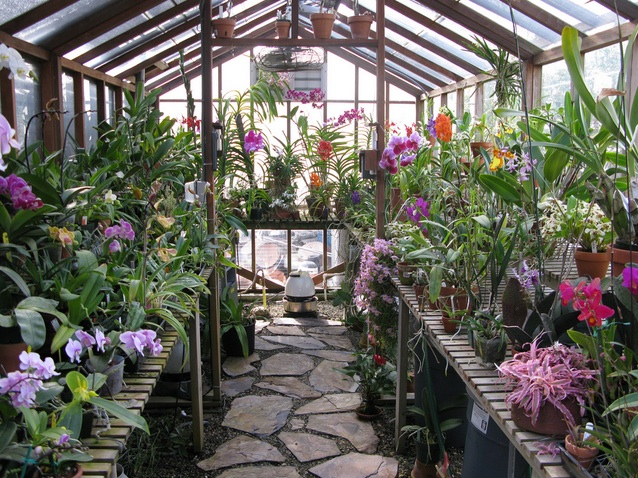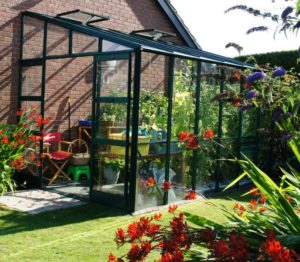Here are just some of the reasons why you might want to build your own greenhouse.
1) You love fresh food.
2) You enjoy beautiful flowers and gorgeous plants.
3) You think gardening is fun, relaxing, and good exercise.
4) You wish your gardening season was longer.
5) You want to save money on seedlings, plants, and food.
Any one of those reasons may be enough to inspire you to install or build your own greenhouse. Here’s how to get started.

Is your goal to get a jumpstart on the growing season by starting seeds you can transplant as seedlings once the weather warms up. Extend the season on the other end and plant a “fall crop” of lettuce, spinach and other greens that you can harvest long after frost makes gardening in the elements impossible? If you live in an arid climate, do you want to grow tropical flowers? Or in a cool climate and want to cultivate cacti? Figure what you want to grow in your greenhouse so you can determine what you actually need to construct.
WHERE? Figure out where you will build your own greenhouse.
Will it attach to the side of your home, garage, shed, barn or other structure? Extend out of a kitchen window? Be freestanding in your yard or garden? Knowing where you will build it will also tell you how big it can be.
TYPE? What type of greenhouse should you choose?
Consider the frame, the covering, and the size. You can see several options at Garden Buildings Direct, our partners in this post and a company that offers reasonably priced greenhouse construction kits. Larger, free-standing greenhouses will need sturdier frames than those that attach to a building or extend out a window. You may also need to put in a floor, both to control pests and temperature, but also to have something to anchor your frame to. Speaking of frames, they come in a wide variety of materials: Aluminium (or aluminum, in the U.S.) will provide a strong, lightweight anchor to your greenhouse covering and will not rust. As greenhouse frames go, aluminium is the most widely used material and is extremely durable. Wood is more natural-looking and also provides ample support and structure. Galvanized steel offers another durable option. If you’re going the hoop-house route, you can use plastic piping that is light-weight and can be easily assembled and disassembled, depending on your needs. West Virginia University offers an excellent backgrounder on how to build your own greenhouse here.
GLASS OR PLASTIC?
Both glass and plastic sheeting are available to cover a greenhouse frame. Tempered glass is often used because it is two or three times stronger than regular glass, though it can still break. Glass also requires a more rigid frame construction than plastic. If you choose plastic, you can get double-layer plastic sheets that last a long time and are quite resistant to damage. However, the downside of plastic is that it is a difficult material to recycle and often ends of creating micro-plastic trash that is difficult to keep out of the environment. Fiberglass sheets are also available. Ultimately, the kind of panel clarity you choose will depend entirely on what you want to grow. Clear panels are perfect if you plan to germinate seeds and grow starters which will later be planted outdoors. The clear panels provide direct light that warms the soil and encourages germinating seeds to sprout. Using opaque panels are perfect if you want to grow plants all the way to maturity. An opaque panel quality is unique as it provides an even amount of light which allows for balanced foliage growth. Generally, clear panel greenhouses provide warmer, more direct light whilst opaque panels are ideal for growing crops long term.
HEATING? COOLING?
If you want to use your greenhouse during the coldest months of the year, you may need to install some kind of heating system, especially for when night-time temperatures drop below freezing. Alternatively, in the summer, you may need fans or a ventilation system to keep plants from baking. By its very nature, a greenhouse collects heat during the day and loses some of it at night. Take this into consideration when planning your greenhouse project. Ideally your greenhouse needs to release hot air in the warm summer months and retain heat during the colder months. Overheating is one of the main reasons why plants sometimes fail to grow in greenhouses, therefore you don’t want your green-house to be too hot. There is usually at least one vent in the roof that you can open in the morning of a hot summer’s day and close during the night. Installing insulation can cut nearly 50% off your heating costs, keep an unheated greenhouse frost free, and is also much better environmentally than using an electric heater.

Do you need to install a hose and spigot in the greenhouse, or can you water everything by hand? It will depend on how large your greenhouse is and what you’re growing.
PESTS?
Yes, you can get insects in your greenhouse. You’ll figure out what your plants can tolerate, and what you’ll have to treat organically and with beneficial predators. Greenhouses generally protect plants from squirrels, rodents, deer, slugs and similar pests.
POLLINATION?
If you’re simply starting seedlings to transplant outside, you won’t need to worry about pollination. If you plan on growing fruits, vegetables and perennial flowers that need pollinating, you will have to do that by hand. Understand the requirements of the plants you choose before you start them growing.
Fertilizer?
One way to generate both fertilizer and heat in a greenhouse is by creating a compost pile in a corner. The compost releases heat as it decomposes. Once the organic matter is decomposed, use it as a healthy organic soil amendment.
Build Your Own Greenhouse to Save Money
Greenhouses are a great way to save money on seeds and plants. The sheltered area of glass transforms the whole growing process for seeds and seedlings and you can produce hundreds of new plants for a fraction of the cost. You can recoup the investment in your greenhouse in no time once you take into account how much money you are saving on store-bought seedlings as well as vegetables and flowers.
Good luck and happy gardening!
RELATED














